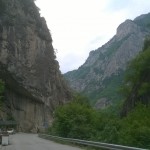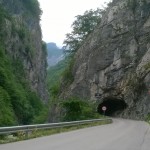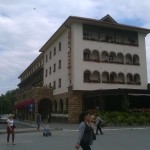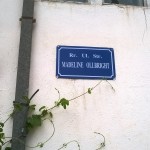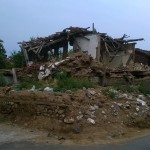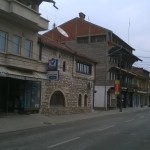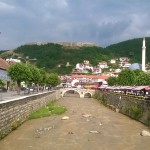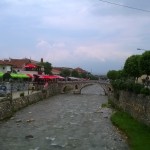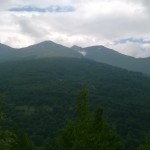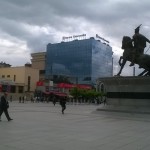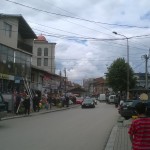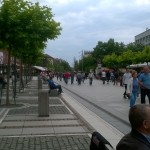Kosovo 2015
CLICK ON PICTURES TO ENLARGE
KOSOVO 2015
In the unlikely event than I am ever a contestant on Mastermind you can rest assured that my Specialist Subject will not be the "The History of Kosovo between 1990 and 2015". As the main source of information for my trip I took the Bradt guide to Kosovo, which is the only really dedicated guide to the country. Bradt specialises in guides to less well-known areas and they are highly respected, but I must admit that I found the sections covering the above-mentioned subject very hard going.
From the creation of Yugoslavia in 1918 until almost the end of the 20th century Kosovo was in effect a semi-autonomous region of Serbia, although a high proportion of the population considered themselves to be Albanian. During the 1990s, as Yugoslavia broke up, ethnic tensions came to a head in most of the former states, and Kosovo was one of the worst affected when the Serbs put pressure on the Albanians, ultimately driving many of them out of the country. The Albanians struck back, aided by NATO forces, with an all out war in 1999, leading to many casualties and widespread destruction of property. This led to a massive ongoing international peace-keeping effort to resettle the displaced Albanian, Serb and Roma populations and rebuild the country. A number of agencies were and still are engaged in this work, examples being KFOR (NATO Kosovo Force), UNMIK (UN Mission In Kosovo) and EULEX (European Rule of Law Mission).
In the early 2000s the precise status of Kosovo was uncertain, but it eventually declared its independence in 2008. That was accepted by the UK, the USA and most EU countries, but it is still not recognised by Russia, China, Serbia and many other nations around the world. If you enter Kosovo directly by air and get a Kosovo stamp in your passport as I did, you cannot cross the border into Serbia, because the Serbs still regard Kosovo as their territory and consider that you have entered illegally.
The nearest I had been to Kosovo was Albania, its western neighbour, which has a quite different history, and I really had no idea what to expect. I arrived at Pristina airport in the evening, and although it was mid-June it was dark by the time I had collected my car from Sixt . This was something I had hoped to avoid, but it always takes longer than you expect to get sorted after a flight. As usual I had booked the first night at a hotel close to the airport and had researched the route very thoroughly, because there is nothing worse than blundering around in the dark in a strange country.
In England there is still a perception on the part of many people that Kosovo is dangerous. The Foreign Office warns of the high level of gun ownership and unexploded mines in some country areas, as well as advising against visiting some Serb-occupied areas in the north. On the other hand, the two ladies who wrote the Bradt Guide pointed out that the murder rate in Kosovo is considerably lower than that in Stockholm.
The Hotel Vita seemed remarkably cheap by general standards and I expected it to be a bit rough, but it was quite good and they produced an excellent meal at about 10.00pm. When I asked the waiters if they spoke English they said “Deutsch”, although the menu that they gave me was in Albanian and English. Maybe they thought I was German, which often happens, but I was later to find that many people in that area have German as a second language rather than English, as a result of having worked in Germany or aspiring to work there.
The hotel was alongside a so-called motorway (M9) and was combined with a large filling station and store called AlPetrol. When Messrs. Carless Capel and Leonard registered the name Petrol for their petroleum distillate in 1870 I doubt whether they expected that it would be used 145 years later in places as far away as Kosovo and Bulgaria. This combination of hotel and filling station is very widespread in Kosovo and there were half a dozen within a few miles on the M9 south of Pristina. Bearing in mind that tourism is still in its infancy I think they are supported to some extent by the large international community working in the country.
As my return flight from Pristina was late in the last evening of the trip I decided to leave exploring the capital city until the end of my stay, and start by going in the opposite direction to a city named Pejë. Kosovo is quite a small country, about the size of Wales, with a good road network linking the main cities, so it does not take too long to get around. An ulterior reason for going to Pejë was the Rugova Gorge road, leading westwards from Pejë to the Montenegran border, where it is blocked to through traffic. It was on an internet list of the world’s most dangerous roads, with photographs of tunnels, sheer drops and overhanging cliff faces.
The M9 from the Vita Hotel to Pejë is a single carriageway road for much of the way, and lined with buildings for most of the distance. Planning controls are virtually non-existent in Kosovo, and it seems that you can build anything you like anywhere you like if you have the land. A particularly striking feature of the landscape is the extraordinary number of part-built houses. Many of them are quite large three-storey buildings which would be expensive in most parts of northern Europe and the economics are hard to understand considering that Kosovo is supposed to be a poor country. Apparently they often belong to people who live in the cities, and are known as “black” houses, because they have no electricity.
The entire country is blighted by a shortage of generating capacity, and power cuts are common, with supplies being rationed on a routine basis in some areas. Many businesses and other people who can afford them have generators, which are inefficient and expensive to run compared to a mains supply, and this situation obviously deters foreign companies from setting up in Kosovo.
Maps of Kosovo are hard to come by in England, and I was using one of the few dedicated maps of the country by Freitag & Berndt obtained via the Internet. It showed an alternative route to the main road between a small town called Klinë and Pejë that I thought might be more interesting, but when I tried to find it it turned out to be a dirt road. On the map it appeared to be good and I realized that the road network was less well-developed than I expected, so there was little choice but to go back to the M9. The map gives the Albanian and Serbian names of every place shown, incidentally, but for this report I am using only the Albanian names.
The plan was go through Pejë, drive the Rugova Gorge Road and come back to the town and stay in a hotel for the night. The town was hectic, but not too difficult, and so far the driving had been much better than I expected, by which I mean other people’s driving. Although they are mostly ethnic Albanians the standard of driving was a great improvement on that in Albania, which is one of the worst countries in the world in that respect. Running red lights and overtaking in the face of oncoming traffic are still the norm, but it is less fast and furious, without the total lack of discipline found in Albania.
Rugova gorge has a long history as a scene of conflict, which is presumably the reason for the military or police checkpoint at the Pejë end. Without noticing it I stopped to set up my video camera, and drove off just as the officer came over to speak to me, but there was no hail of bullets, so I think he decided that I was too old or looked too frail to be planning to overthrow the state.
The description of the gorge proved to be correct, with tunnels, overhanging cliffs and sheer drops rising to about 2000ft above the river. One tunnel was very narrow and dark, with a sharp bend in the middle of it. Even though there was little traffic it was difficult to take photographs while I was driving, and excellent pictures of the road hazards and scenery can be found by putting Ruguva Gorge Road into Google. The area is popular with walkers and climbers, although the guide books advise sticking to well-
used paths because a lot of mines have still not been cleared. The distance to the border with Montenegro
is about 16 miles, but shortly before that I turned onto the mountain road to the rather unfortunately named village of Bogë. Like most other places in Kosovo it is in a state of development, in this case with the intention of becoming a ski resort for Kosovars who cannot afford to go abroad. It has a very pleasant Alpine atmosphere despite the obligatory half-finished houses dotted around.
Pejë
Regular readers, if there are any, will know that it is very unlike me to stay in the best hotel in town, but that is what I had booked in Pejë. I am not sure whether it is actually the best, but it is probably the hardest to get to, due to the complicated network of one-way
streets. It claimed to have secure on site parking, but this turned out to be an area of public pavement next to the hotel, watched over by a man in a little hut. The Hotel Dukagjini certainly had a wide selection of amenities, all for about one third of the price you would have to pay in Britain. It was adjacent to the main square in the town centre, and had a recently-built terrace alongside the river at the back.
Once sorted, I went for a walk to take in the sights of Pejë. This region of Kosovo was one of the most seriously affected by the 1999 war, and the town was largely destroyed. A few damaged buildings are to still to be found, but by and large it seems to have made a
good recovery, although according to the guide book much of the original character of the central area has been lost. A rather amusing feature of Kosovan towns is the naming of streets after western leaders who backed the people fighting Serbia in the war. Examples in Pejë are Madeline Ollbright Street and General Wesley Clark Street. One disappointment was that after an intensive search I failed to find Tony Blair Street, although it definitely exists.
Pejë was traditionally a centre for fine hand-made jewellery and still has an astonishing number of shops and stalls offering such products, but nowadays much of it comes from China and is obviously of poor quality. If it is bling that you are looking for you will find it in abundance in Pejë.
The town also has some excellent examples of kullas, the traditional Albanian fortified towers with thick windowless walls on the ground floor, living accommodation on the first floor and more rooms with a sort of open balcony on the second floor. They were targeted by Serb forces in the war, and most of the existing ones have probably been rebuilt. The architectural style is reflected in many modern buildings, including some ‘black houses’
The next stage was to drive to Prizren, a fairly large city in the south of the country, via Dečan and Gjakovë. Just outside Dečan is the Visoki Dečani Monastery, described by Bradt as “the undisputed highlight and a real must for any visitor to Kosovo”. It is guarded by Italian KFOR (NATO) soldiers who took my passport and exchanged it for a badge to be worn on the premises. As I went into the grounds I heard one of them laboriously spelling out my name to another who was writing it down, though for what purpose I have no idea.
The monastery was a haven of tranquillity with a central chapel surrounded by ancient buildings that were not open to visitors apart from the shop and toilets. Photography is not permitted. The chapel itself was dark inside, with a vast number of faded murals extending right up to the high ceiling. The guide book suggested taking a torch to view the murals, but I would not really care to wander around flashing a torch powerful enough to illuminate the murals on the ceiling. The church is actually a Serb structure from the 14th century and has come close to destruction several times in this region of ongoing conflict.
Some distance the other side of a town called Gjakovë I stopped for coffee at a roadside bar where I was subjected to a rant in German by the elderly owner about Churchill and immigration. Churchill was apparently responsible for the state of post-war Europe and it was very unreasonable for our present government not to give Kosovars unrestricted entry to Britain. He refused to take payment for the coffee, presumably as a reward for listening to him.
Eventually I managed to get away, and completed my journey to Prizren via a scenic but poorly surfaced mountain road through a place called Zym
Prizren
On the outskirts of town I found Motel Nafron, recommended by Bradt, and went on to park in the centre, or so I thought. In fact the town was larger than I realised, and despite the book and navigational aids I got lost. There were few people around apart from some men working behind railings in front of the fire station. One of them spoke a little bit of English and told me the direction to the shops. He was wearing a fleece jacket with Devon and Somerset Fire & Rescue Service embroidered on it, so I pointed at the lettering and said “You’re not in Devon and Somerset Fire & Rescue Service.” He laughed, looked across the station yard and said “Fire engine”. At the back of the yard was a red British fire engine that had presumably been donated to Prizren, along with the jacket, at the end of its working life in Britain.
Unlike the outskirts, the central area of Prizren was very attractive, with a river running through it and castle high on a hill in the background. A fitting home for the fire engine in its retirement. The river was spanned by several quaint stone bridges and lined with shops and restaurants, all of which seemed to be thriving. The general atmosphere did not seem compatible with the idea of a town that could not afford to buy a fire engine, which I later discovered had been driven from England less than a year before my visit.
As I was wandering about the main streets I suddenly became aware of the roaring of generators and realised that one of the famed power cuts was in progress. The shops remained open regardless of whether or not they were in near darkness, and nobody seemed at all bothered.
Ferizaj and the Bifurcation (maybe)
When I left the motel the next morning the owner was working on the forecourt with a hose and decided to wash my car , a service for which he refused to accept any payment. It was time to drive back to Pristina and instead of taking the motorway I elected to go via a town called Ferizaj, which took in a scenic route through a national park close to the border with Macedonia.
Ferizaj.is an ordinary town but quite lively, and when I parked the car to look round I saw a sign on a roundabout pointing to BIFURCATION. This is a word that I was not familiar with, and I thought it sounded slightly rude, but remembered seeing a reference to it in the guide book.
A bifurcation is a place where a river divides and flows away in two different directions. At first thought this does not seem particularly remarkable, but in fact it is very rare, and the one near Ferizaj is the only one in Europe. The river is the Nerodime, which splits near the village of that name, a few miles west of Ferizaj.
It was rather late in the day, considering that I had to get to Pristina, but I decided to go to Nerodime in search of the bifurcation. There were only a couple of direction signs, so I had to find the village using my map, which was not difficult. The river, however, was elusive, and after driving miles around the area I could only find a few streams, which ran around in all directions. There was no clearly defined division, but looking at pictures and videos on the internet afterwards I think I did see it. It is just that it was less imposing than I had expected.
After this anti-climax the motorway to Pristina almost seemed exciting. It was more like a proper motorway than the M9 with few turn offs and I finished up going about 30 miles too far on the way to the Hotel Vita.
Pristina
Once the commuter traffic had cleared the next morning I drove into the capital city and found somewhere to park all day at no charge within walking distance of the centre. Try that in London or Brighton.
A long street called Agim Ramadani took me past the University, the Art Gallery and the National Theatre, until I came to a large open space with a statue of a bloke on a horse in front of the modern parliament building. The man was Skanderbeg, the most prominent Albanian national hero, who in the 15th century fought valiantly though ultimately unsuccessfully to prevent the advance of the Ottoman empire.
Working my way northwards brought me to the Old Town with its clock tower and enormous market area. A notable feature of the market was the large number of stalls selling hardware, especially for outdoor use, which suggests that a lot of people have gardens or land of some sort. Unlike most former communist countries Kosovo does not seem to have the vast austere blocks of flats in the suburbs of its towns.
Another thing Kosovo is lacking is public lavatories. I could not see any in the market, but with the large number of stall holders I assumed that there must be some facilities, and I was directed to the far end of one of the gangways. A man sat on a chair in front of the Gents, the horrors of which exceeded anything I saw in the French campsites of my youth or the hutongs of Beijing. As I emerged trying not to choke he indicated that he expected to be paid and rather stupidly I gave him fifty euro cents (about 40p, the usual going rate), which was greeted with a grunt of dissatisfaction.
The route back to the car was via a wide pedestrianised boulevard, with lined with restaurants and crowded with people even on a Tuesday afternoon.
A short diversion took me to the Newborn Monument, a strange piece of sculpture created to celebrate the country’s independence. It consists of giant capital letters spelling NEWBORN, deliberately covered with graffiti as an expression of the nation’s new found freedom.
On the way to the airport I turned off the M9 to find somewhere to stop to sort the car out before handing it back and within a short distance found myself in the middle of a Roma encampment, with people washing cars, children tearing about on bicycles and mud all over the road. Just what I wanted when I was trying to keep the car clean.
First impressions of Kosovo with its ribbon building and lack of planning control might lead some people to see it as a dump, but in many respects I quite liked it. There is beautiful countryside if you venture off the beaten track, most of the people are friendly and it is undeniably cheap. In my estimation a British pension would stretch about two and a half times as far as it does at home.
